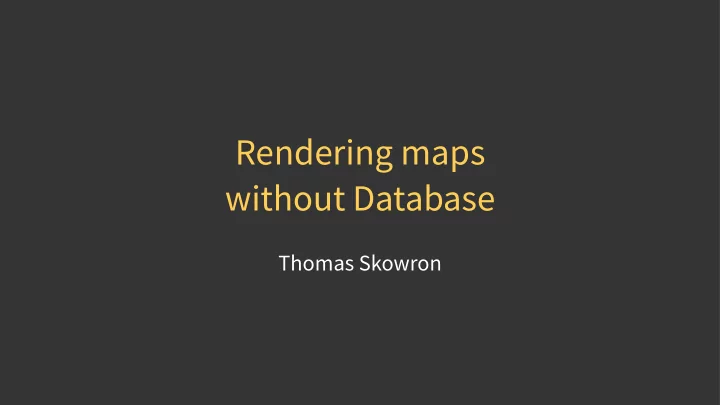

Rendering maps without Database Thomas Skowron
Previously (if you happen to speak German) „Überblick über „Pipelinebasierte Rendering-Techniken Erzeugung von und So fu ware“ Karten“ FOSSGIS-Konferenz 2017 FOSSGIS-Konferenz 2018
Turning OSM Data into a graphical map
Bitmap/Vector Tiles, Maps with larger extent, …
State of the art
OSM Planet Bottleneck Awesome, powerful stu ff Bottleneck PostgreSQL Bottleneck Renderer
PostgreSQL + SQL - Performance (PostGIS) + ACID, MVCC & transactions - operational cost + Indexes - memory consumption + Role permission management + scriptable + fail over + … Do we really need all of that stu ff ?
Attempts to improve the situation…
OSM Planet Bottleneck Bottleneck PostgreSQL Bottleneck Vector File “Renderer“ Client Based Renderer
All features Pre-rendered Vector already baked in, Tiles flexibility mostly gone Client Based Renderer
Alternative Approaches
tippecanoe
OSM File mbtiles vector tile set
Clever features to keep vector tiles small
has a gazillion of options
still very limited to filtering
Tilemaker
flexibility through lua scripting
not scalable to larger extracts
But why does one tool needs to do everything?
Generally, we are all doing almost the same stu ff .
Step 1 Convert OSM data into geo data
Step 2 Filter
Step 3 Transform/map data
Step 4 Convert into target format
Suggestion: parse | map-reduce | render
But how?
With Tools, which each do one thing well
and a portable data format
Let’s do Shapefiles!
Let’s do Shapefiles!
Let’s do OSMPBF!
Let’s do OSMPBF!
What does a suitable file format need?
Performance linear writes, parallelizable reads
Scalable small to huge data sets
Tag structures No tables no more!
Future proof adaptable to change
Shapefile Performance moderate Scalable no, 2 GB size limit Tag Strucutre no Future Proof no
GeoJSON Performance moderate Scalable moderately, single threaded Tag Structure yes Future Proof limited
GeoPackage Performance bad (SQLite) Scalable moderately Tag Structure yes Future Proof yes
Performance Flexibility
We need something new There is no progress without change
How would a new file format look like? • binary • blocks, streamable • single stream, not multiple files • not SQLite • not overly obscure • open and extendable
Suggestion
Based on Protocol Bu ff ers and WKB
Open Spec on https://thomas.skowron.eu/spaten/
Reference implementation in Go github.com/thomersch/grandine/lib/spaten
Around 50% smaller than GeoJSON* * YMMV
Version 0
Feedback and Ideas are welcome
What could we do with it?
grandine-spatialize -in planet.osm.pbf -mapping roads.yml | grandine-tiler -out tiles/roads/ -zoom 14
osmium export -f spaten planet.osm.pbf | gradine-converter -mapping roads.yml | grandine-tiler -out tiles/roads/ -zoom 14 (not yet)
osmium export -f spaten planet.osm.pbf | your-tool-here -fancify | magic-renderer (not yet)
Interchangeable tools
Future
Greater flexibility with less programming work
Faster processing with less hardware
Less points of failure
There is still lots to do Data format, tools, markup, …
Let’s build the future together!
And now let’s discuss!
Recommend
More recommend